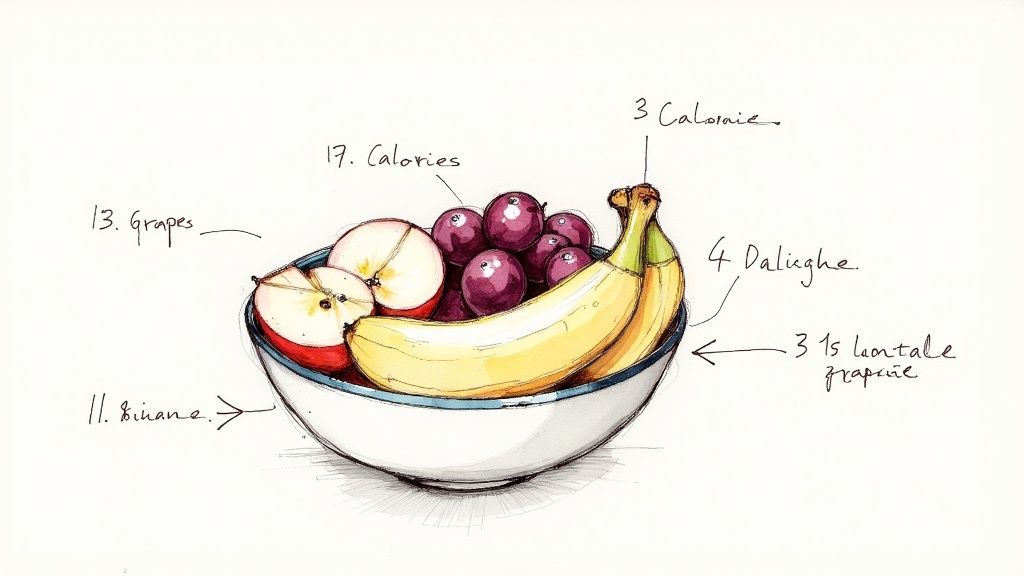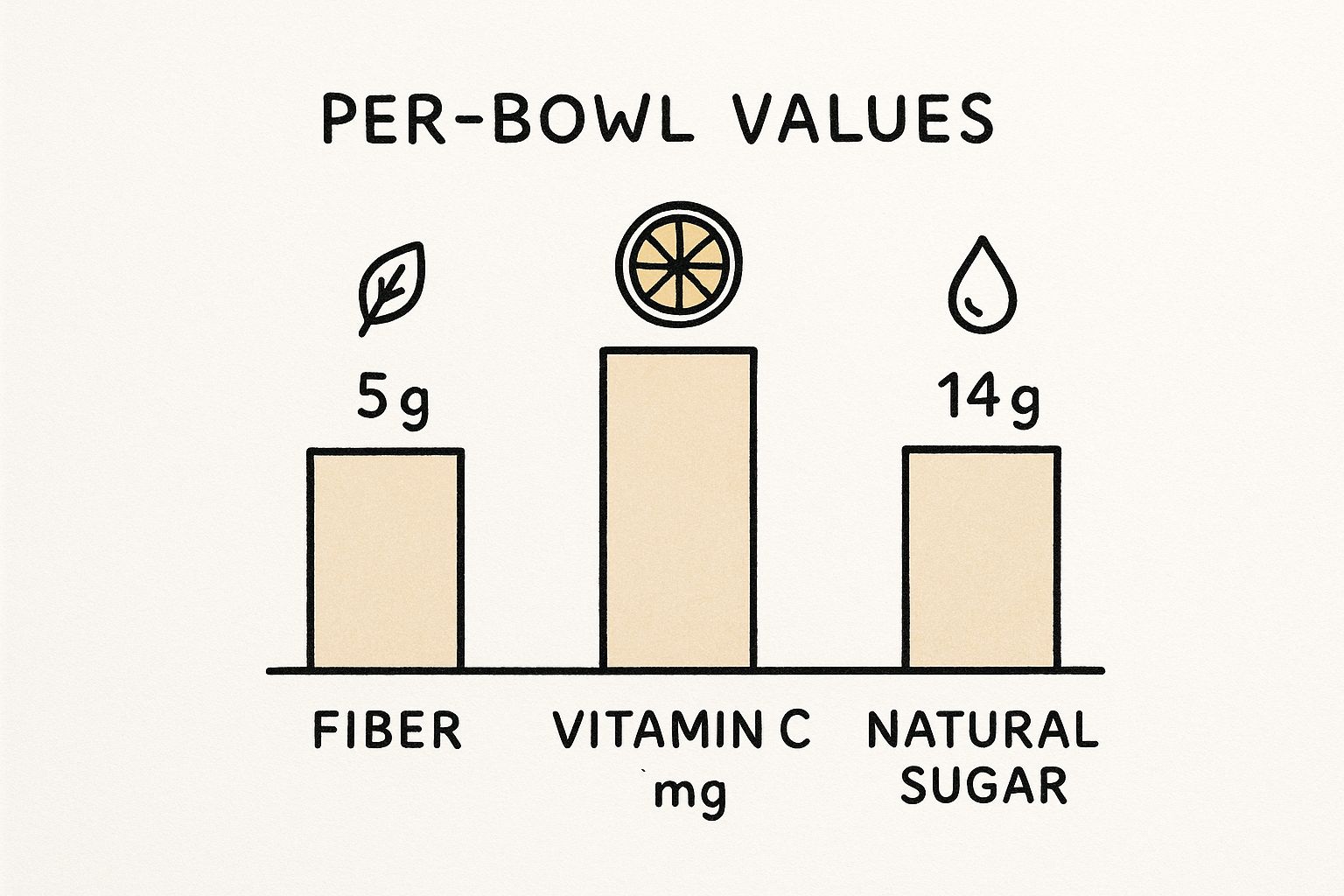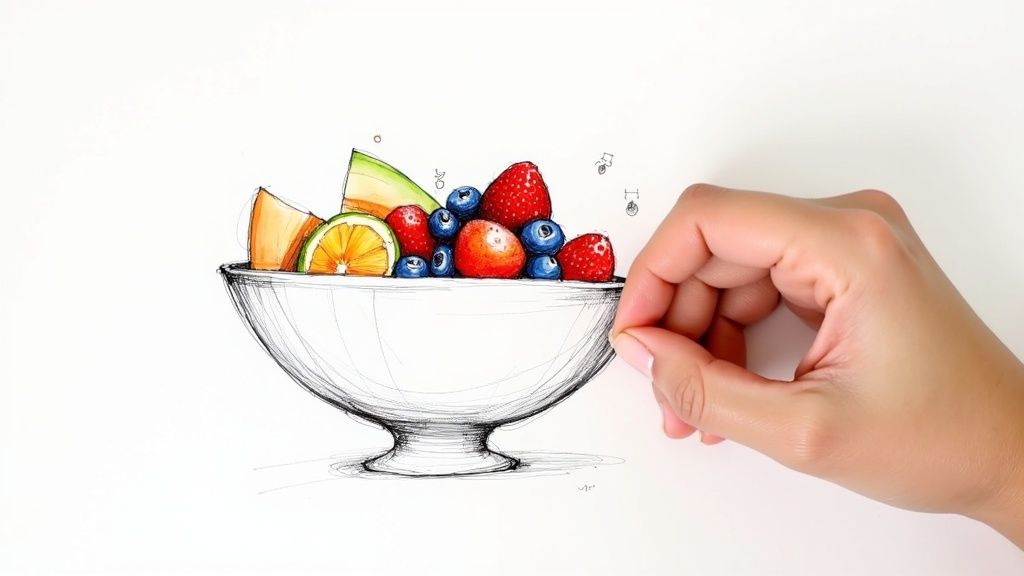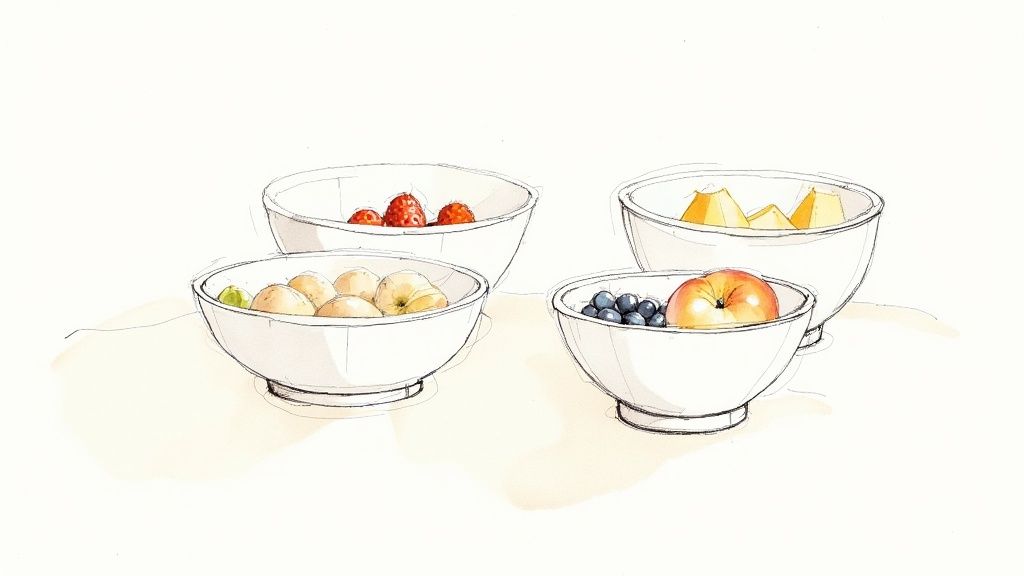How Many Calories Are in Your Fruit Bowl? (It's Less Than You Think)
Discover the calories in a fruit bowl, including fruit types, portions, and toppings. Find out how to enjoy a tasty, healthy snack while tracking calories easily.
Posted by
Ever look at a colorful fruit bowl and wonder, "So, what am I really eating here?" It’s a great question, and the answer is refreshingly simple. Generally, a standard one-cup serving of mixed fruit will land you somewhere in the 150 to 250 calorie range.
Knowing this little fact can be the difference between seeing it as a light snack or a more substantial mini-meal. It’s all about context!
Why Fruit Bowl Calories Can Vary So Much
A fruit bowl might seem straightforward, but the calories inside can swing quite a bit depending on what you toss in. Think of it like making a smoothie—adding a banana will give you a different result than adding a handful of spinach. The same idea applies here; some fruits are naturally denser and sweeter, which means more calories.
The goal isn't to get you to weigh every single grape. It's about building a casual awareness so you can throw together a bowl that fits your goals without any stress. Understanding these little differences helps you get a better handle on your daily intake, which is what mindful eating is all about. You can see how these smaller meals fit into your bigger picture by checking out our guide on how to calculate daily calorie needs.
Denser Fruits vs. Watery Fruits
So, what's the secret to the calorie count? It almost always boils down to two things: sugar and water.
- Higher-Calorie Fruits: Think of fruits like bananas, mangoes, and grapes. They're more calorie-dense because they pack more natural sugar (aka energy!) and have less water.
- Lower-Calorie Fruits: On the other hand, watery choices like watermelon, cantaloupe, and strawberries are much lighter on calories. They're mostly H₂O, which makes them super hydrating.
To put it in perspective, one medium banana has about 105 calories. Compare that to a full cup of watermelon, which only has around 46 calories. It's easy to see how a bowl filled with melon and berries will be way lower in calories than one loaded with tropical fruits.
Why Fruit Bowls Are More Than Just Calories

It’s so easy to get fixated on numbers. But before we get lost in the details of calorie counting, let's zoom out and look at the bigger picture. Knowing the calories in a fruit bowl is handy, but it’s just one piece of a much tastier story.
Every piece of fruit in that bowl is a little nutritional powerhouse. They're loaded with essential vitamins, minerals, and antioxidants your body loves. Plus, the high water content is great for hydration, and all that natural fiber helps you feel full and satisfied for longer. It’s a combo that genuinely supports everything from your energy levels to your digestion.
The Feel-Good Factor
Grabbing a fruit bowl isn't just about picking a low-calorie option; it’s an act of mindful eating. You’re giving your body something that’s not only delicious but also incredibly good for you. Shifting your mindset this way is what casual tracking is all about—it's less about restriction and more about celebrating the good stuff you're putting into your body.
A fruit bowl isn't a sacrifice; it's a nutritional upgrade. It’s one of the easiest and most enjoyable ways to boost your well-being with real, unprocessed food.
This focus on whole foods is a global movement. As health awareness has climbed, the worldwide availability of calories from fruits and vegetables shot up by 61% between 1990 and 2019, far outpacing population growth. You can dive deeper into this shift by exploring global fruit consumption trends.
So, when you log that bowl, remember you're not just tallying calories—you're acknowledging a fantastic choice for your health.
How to Build Your Ideal Fruit Bowl
Let's get practical. How do simple choices actually shape the nutrition in your fruit bowl? The goal isn't to get the math perfect; it's about understanding the big picture of what you're eating. You can ditch the food scale for this—a coffee mug or even your hand works great for estimating a reasonable portion.
To show you how much the calories in a fruit bowl can vary, we'll break down three common styles. Each one serves a different purpose, making it easy to build a bowl that fits your mood and your needs.
Choosing Your Bowl
The kind of bowl you build really comes down to what you want out of it. Are you looking for a light afternoon bite? A quick energy kick before the gym? Or maybe a balanced mix to keep you full between meals?
The Light & Refreshing Bowl: This is your go-to for a low-calorie, super-hydrating snack. Think watery fruits like watermelon, cantaloupe, and a handful of strawberries. A bowl like this usually comes in under 150 calories and is an absolute lifesaver on a hot day.
The Energy Booster Bowl: Need a fast pick-me-up? This is the one. Combine more calorie-dense fruits like a sliced banana with a generous handful of grapes. It’s naturally higher in sugar for that quick burst of energy and typically lands in the 250-300 calorie range.
The Balanced Mix Bowl: For the best of both worlds, this is it. Mix up fruits like apples, oranges, and kiwi. You'll get a fantastic combination of fiber, vitamins, and moderate calories—often around 200 calories. It’s a great, well-rounded choice that keeps you feeling satisfied.
Take a look at how these three bowl types stack up. It’s a great visual for seeing how your fruit choices impact things like fiber, vitamin C, and sugar.

As you can see, the Energy Booster is highest in natural sugars, while the Balanced Mix gives you a fantastic middle ground for both fiber and vitamin C.
This table gives a clearer picture of how ingredient choices can dramatically change the nutritional profile of your bowl.
Example Fruit Bowl Nutrition Profiles
| Fruit Bowl Type | Example Ingredients | Estimated Calories | Primary Benefit |
|---|---|---|---|
| Light & Refreshing | Watermelon, cantaloupe, strawberries | ~150 | Hydration, Low-Calorie |
| Energy Booster | Banana, grapes, mango | ~250-300 | Quick Energy, Pre-Workout |
| Balanced Mix | Apple, orange, kiwi, berries | ~200 | Fiber, Vitamins, Satiety |
Ultimately, each bowl serves a purpose. It's just about matching the right combination of fruits to what your body is asking for at that moment.
And the best part? Logging these is super simple with voice. Just say, “I had a bowl of banana and grapes,” and an app like munchlog.ai can provide a smart estimate, no tedious typing required.
Don't Forget the "Sneaky" Calories in Your Toppings

A bowl of fresh fruit is a brilliant, healthy choice. But let's be real—it's the toppings that often make it truly satisfying. A sprinkle of granola, a dollop of yogurt, a drizzle of honey… these extras add incredible flavor and texture, but they can also quietly add a lot of calories.
Think of it this way: your bowl of fruit is the main event, and the toppings are the accessories. It's easy to accidentally turn a light snack into something more substantial if you're not paying attention.
Making Smarter Topping Choices
Without realizing it, you can easily double the calories in your snack. That light, 200-calorie fruit bowl can quickly become a 400-calorie mini-meal. The trick is simply being mindful of what you're adding and how much. For instance, a single tablespoon of honey brings about 64 calories to the party, while a generous dash of cinnamon adds flavor with almost none.
Let's break down some common fruit bowl companions:
- Granola: Just a quarter-cup of your average store-bought granola can pile on 100-150 calories, usually with a hefty dose of sugar. For a similar crunch, a small handful of almonds has around 80 calories but adds healthy fats and protein.
- Yogurt: Creamy Greek yogurt is fantastic for a protein boost. Just watch out for flavored versions, which are often packed with sugar. Sticking with plain yogurt gives you full control.
- Honey and Syrups: Delicious, yes, but these are essentially pure sugar. A tiny drizzle is often all you need for that perfect touch of sweetness.
- Nuts and Seeds: These are nutritional powerhouses, full of healthy fats and protein. Since they are calorie-dense, a small handful is the perfect portion for adding a satisfying crunch and great nutrients.
This isn't about avoiding your favorite toppings. It's about awareness. Knowing how these additions impact the total calories in your fruit bowl gives you the power to build a snack that truly aligns with your health goals.
This is where a simple tracking tool can be a game-changer. You don't need to pull out the measuring spoons every time. Just making a quick voice note like, "...with a handful of granola and a drizzle of honey" in an app like munchlog.ai gives you a much more accurate picture of your intake without the typical food-logging stress.
How Portion Size Changes the Game

It sounds almost too obvious, but the bowl you grab from the cabinet can completely change the story of your fruit salad. The difference between a small cereal bowl and one of those big soup bowls can easily double the calories you’re eating, often without you even realizing it.
This isn’t about being restrictive. It's simply about being aware. When you’re tracking your food, the real goal is to build an intuitive sense of how much you're actually eating. That small shift in awareness is what makes tracking feel easy and natural over time.
Easy Ways to Eyeball Your Servings
You don't always need to break out the food scale. Believe it or not, you’ve got a pretty handy measurement tool attached to your arm. For most fruits, a quick visual guide is all you need to get a solid estimate without stressing over perfection.
Here are a few no-fuss ways to gauge your portions on the fly:
- Your Fist: A closed fist is a surprisingly good stand-in for about one cup. It’s perfect for estimating a serving of berries, melon chunks, or grapes.
- Your Palm: The palm of your hand works well for denser, sliced fruits like bananas or mango.
- A Coffee Mug: Most standard coffee mugs hold about one cup, making them a consistent and convenient measuring tool when you're in a hurry.
Mastering portion awareness is the key to effortless tracking. It transforms calorie counting from a chore into a simple, mindful check-in.
This kind of mindful eating is catching on. With more people embracing healthier habits, the global fruit market is expected to balloon from US$735.65 billion to over US$1,106.08 billion by 2032. You can read more about these fruit and vegetable consumption trends on ibisworld.com.
Whether you're at home or grabbing a fruit cup on the go, having a good sense of portion size makes logging your food with just your voice so much more effective. If you want to dive deeper into precision, check out our guide on how to weigh food for weight loss for more tips.
A Smarter Way to Track Your Fruit Bowl: Just Use Your Voice
So, we've covered how different fruits, toppings, and portion sizes can change the calorie count of your fruit bowl. But now for the big question: how do you actually keep track of all that without it becoming a full-time job?
Traditionally, you'd have to pull out your phone, manually search for every single ingredient, guess the weights, and painstakingly enter everything into a tracking app. Let's be honest, that process is tedious and why most of us give up.
This is exactly where a more casual approach makes all the difference.
Instead of typing, searching, and weighing, what if you could just speak? Imagine saying, "I had a fruit bowl with strawberries, banana, and a sprinkle of almonds," and being done. That’s the idea. Munchlog’s AI handles the rest, instantly giving you a smart estimate of the calories and macros without all the manual work.
This hands-off method is a game-changer for anyone who wants to be mindful of their nutrition but doesn't have the time or patience for old-school tracking. It’s all about making consistency feel effortless.
This simple shift removes the friction that causes so many people to quit tracking their food. The goal isn't to be perfectly precise down to the last gram; it's about building sustainable awareness. For a closer look at this modern philosophy, check out our complete guide on how to track calories the easy way.
With voice, logging what you eat becomes a quick, two-second habit that actually fits into a busy life.
Your Fruit Calorie Questions, Answered
Let's be honest, figuring out the deal with fruit, sugar, and calories can sometimes feel a little tricky. Here are some straight-up answers to common questions so you can build that fruit bowl without a second thought.
Is the Sugar in Fruit Bad for You?
Nope, not in the way you might think. The sugar in whole fruit is called fructose, but it comes packaged with a whole team of good stuff: fiber, water, vitamins, and antioxidants.
That fiber is the real hero. It slows everything down, meaning your body absorbs the sugar gradually. This prevents the crazy blood sugar spikes and crashes you get from candy or soda. It’s clean, steady energy.
To Lose Weight, Should I Skip High-Calorie Fruits?
Definitely not. It's true that a banana has more calories than a cup of watermelon, but it's not "bad." That banana is also loaded with potassium and is super filling, which can actually help you feel satisfied and eat less later.
A healthy lifestyle isn't about cutting out entire food groups. It’s about variety and being mindful of your portions. Enjoy all the fruits, just keep an eye on how much you're eating at one time.
The accuracy of tracking a fruit bowl with your voice is all about smart, convenient estimation. When you log "a bowl of fruit," an AI-powered app gives you a calorie count for a standard serving. The more detail you add—like "a large bowl with banana and granola"—the sharper that estimate gets. The aim is consistent awareness, not gram-for-gram perfection.
Ready to stop guessing and start tracking effortlessly? With munchlog.ai, you can log your fruit bowl and everything else you eat just by speaking. Get your smart nutrition estimate in seconds. Learn more at https://munchlog.ai.